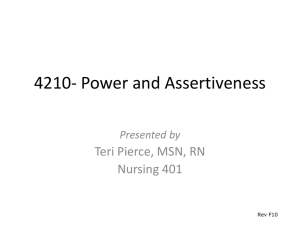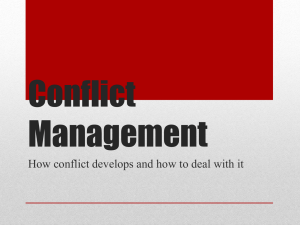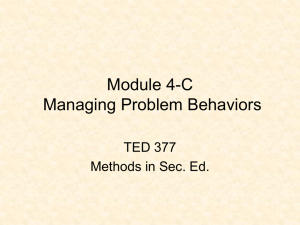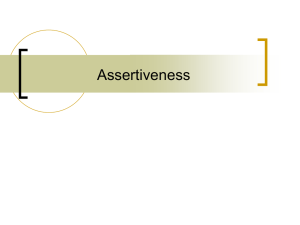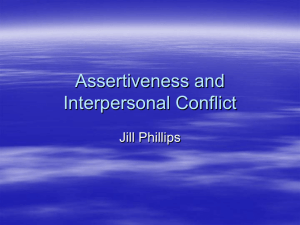Healthy Boundaries - World Vision Australia
advertisement
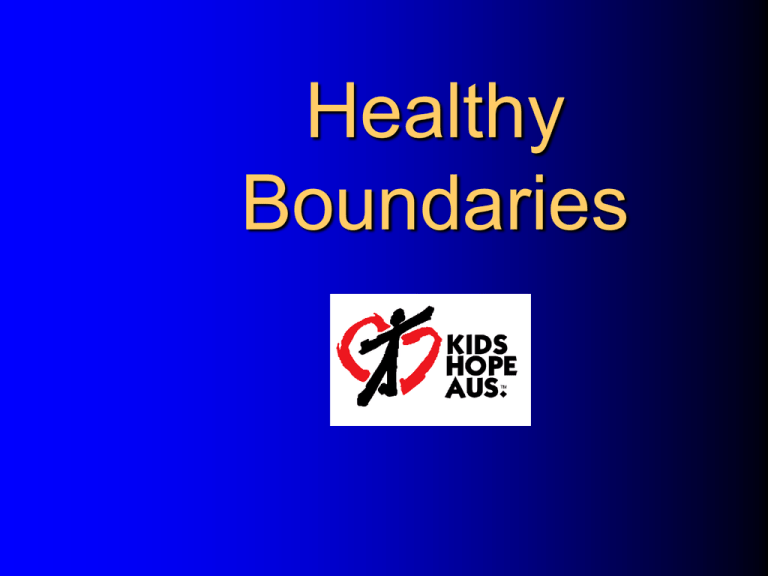
Healthy Boundaries Objectives •What are boundaries? •Why we need to set healthy boundaries? •How we set healthy boundaries? Healthy Boundaries What are boundaries? Boundaries define what is me and what is not me. They are the limits you set around time, who you let into your life, what activities you undertake. Good boundaries mean that you spend your time and energy wisely. Boundaries also protect– they keep you ‘safe’ and support your wellbeing. You began learning boundaries as a child. To keep a lamp burning, we have to keep putting oil in it. (Mother Theresa) Boundaries are what protect our integrity, our rights and our sense of self, by distinguishing our feelings and needs from those of others. Boundary setting is a way to support yourself and others. One of the skills we can use in setting healthy boundaries is to be assertive. Assertive – what does it mean? Understanding and exercising your rights, expressing them clearly and directly, while being aware of and respecting the rights of others. What is aggression? Directly standing up for your rights and expressing your thoughts, feelings and beliefs in a way that is often dishonest, usually inappropriate and always violates the rights of other people. What is non assertion? Violating your own rights by failing to express honest feelings, thoughts and beliefs and consequently permitting others to violate your rights. Key Points about Assertiveness •Assertiveness is a skill that can be learned •Everyone has their own ‘style’ – there’s no one right way to be assertive •Assertiveness is a choice – you can choose to be assertive or not •Assertiveness involves knowing yourself and what you want •Assertiveness can mean taking a risk and the responsibility for the consequences If I act submissively towards you I convey to you that you count but I am unimportant. If I act aggressively towards you I convey to you that I count but you are unimportant. If I act assertively towards you I convey to you that we both count and are both important. What is assertive communication? Assertive communication allows you to clarify communication and stand up for yourself without making things worse or getting a negative result or response. Four steps to Assertive Communication Step 1 – Send clear messages To communicate clearly, look at your posture and your facial expressions, as well as your hand and arm movements. Pay special attention to your tone of voice which can say volumes beyond your words. Step 2 – Learn how to listen Assertive people have developed their listening skills. While hearing is done with your ears, true listening is done with your heart. To be a better communicator, start by becoming a better listener. Step 3 – Start the conversation with “I feel” rather than “you should” Words have tremendous power to determine how other people experience us, and how they respond to an issue. For this reason, people with good assertive communication skills focus on the problem behavior (and not the character of the person), stick to the point, don’t use labels, and make “I” statements rather than “you” statements. Step 4 – Acknowledge your part in the conflict Anger is often an escalating process, involving 2 people who create a negative feeling in each other, sometimes instantly and sometimes over a long period of time. It is natural to blame someone else entirely for the problem, especially when we are angry or in a defensive mode. But, once we return to normal, the assertive communicator is able to accept some of the responsibility for the conflict. This acceptance and acknowledgment of your contribution to the problem is an indication of emotional maturity and can create an entirely different atmosphere. Whole messages or Empathetic Assertion we speak in shorthand – give half a message. For example “I haven’t got time to take you to the park today.” •The whole message might be: “I wish I could take you to the park today, but I don’t have time. I’d love to take you another day.” •Whole messages show understanding even if you are unable to meet the request. •Often “I understand that you ….. but I ……” eg “I understand that you are feeling lonely today, but I am unable to stay any longer.” •Empathetic Assertion expresses an attempt to put yourself in the other’s shoes as well as giving a self assertive message. It is a friendly and gentle way of being assertive. •Empathetic assertion affirms the need but offers a polite refusal. •Formula: Whole message or Empathetic Assertion •Affirm the need but give polite refusal •Express understanding, but say ‘no’ FORMULA I understand that you ….but I …… Practice with these examples I understand that you ……….but I ….….. •Can you lend me your car tomorrow? I need to get to the library. •Would you just do these extra jobs after you have finished your regular jobs today? •Could you just stay half an hour more? I am lonely. •Could we just stop at the supermarket, chemist, bank and post office on the way home from the doctors? •I know you just came to visit, but could you please weed the garden for me? Setting appropriate limits •People caring for others often have difficulty setting appropriate limits and protecting themselves. •Most people (except 2 year olds) find saying ‘no’ hard. •Some ways of saying no are better than others, depending on the situation. If a child is about to run on the road, you yell ‘no’ without giving reason. There are more friendly ways of saying ‘no’ if you wish to refuse a request. •Sometimes it is tempting to say ‘no’ with white lies or false reasons. This can lead you into deep water. •The best way is through empathetic assertion: express understanding, make a polite refusal. •If the other person is a bit manipulative, avoid making suggestions about other ways of solving the problem. Remember that you have the right to say ‘no’. Practice Saying NO •Saying NO without explanation •Saying NO with false reasons •Saying NO and suggesting alternatives •Saying an empathetic NO “I understand that you …. but I am not …. because …..” Sample scenarios •I’m having a party tonight and I’d like to borrow your CD player. •Come and have dinner with me tomorrow night. •Can you do some weeding for me today?
